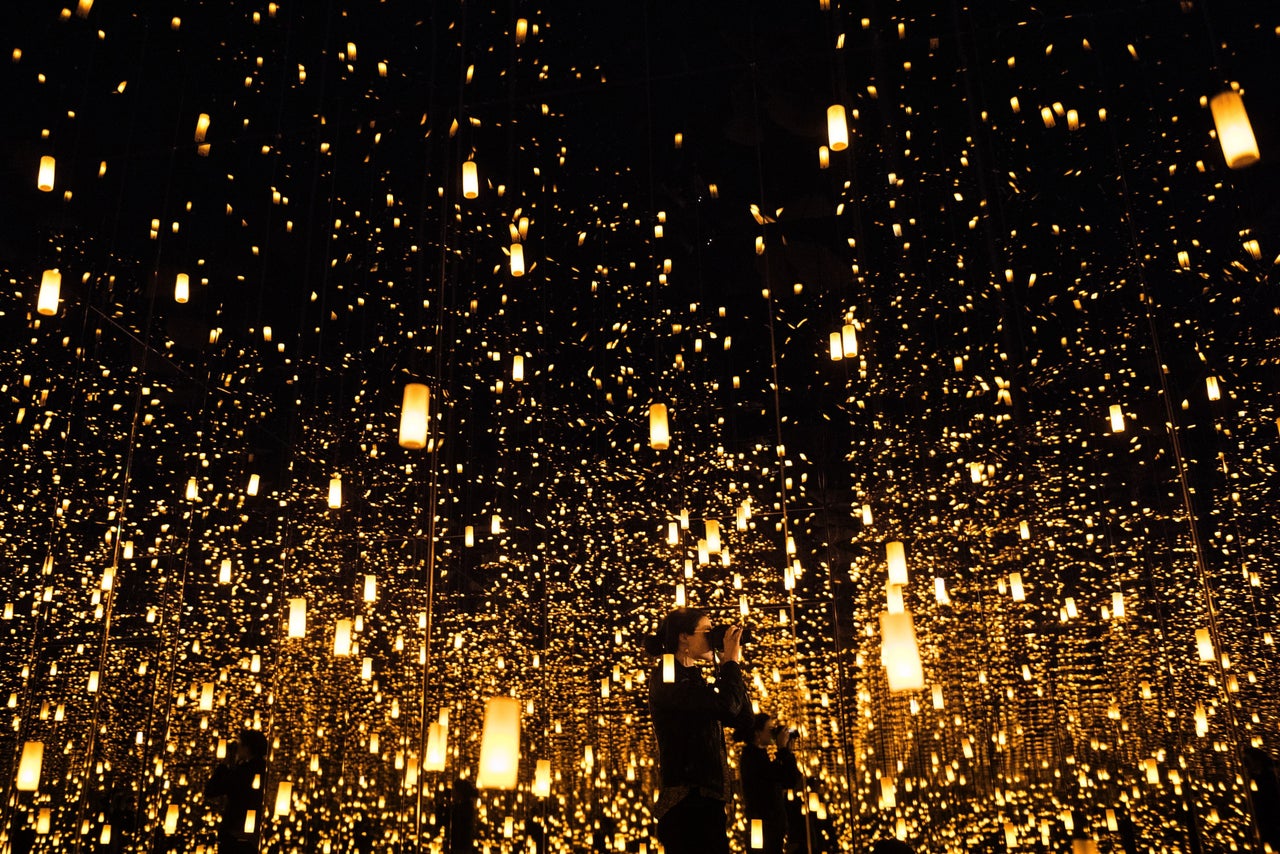The exhibition “Yayoi Kusama: Infinity Mirrors” opened Thursday at Washington D.C.’s Hirshhorn Gallery. The show features 70 years of the iconic Japanese artist’s work, including six of her buzzy “infinity rooms.” The mirrored, enclosed spaces are meant to be experienced alone to give the viewer an impression of entering a boundless realm with surfaces reflecting one another back and forth, forever.
Every day, thousands of museum visitors are expected to wait in line to enter these profoundly trippy rooms for approximately one minute at a time. Often, patrons will commemorate this minute with a photograph. The photos will likely, then, be uploaded to various social networks. Each digital image, itself a snapshot of infinite reflected images, will join an endless stream of so many more. As the museum hashtag aptly calls it, #InfiniteKusama.
So even if you never see “Infinity Mirrors” in person, you’ll surely see it spread across your various timelines and feeds. As images of the exhibition disperse wildly across the web, Kusama’s work operates in a state of in-between, with one foot in the material museum space and another in the immaterial world of the internet.
When Kusama began creating art as a child in 1930s Japan, there was, of course, no such thing as the internet. And yet ― through her paintings, sculptures and, most of all, “infinity room” installations ― the artist seems to divine the future of a sprawling space where our immaterial selves can proliferate, congregate, mutate and network.
A space of radical connectivity and profound isolation.
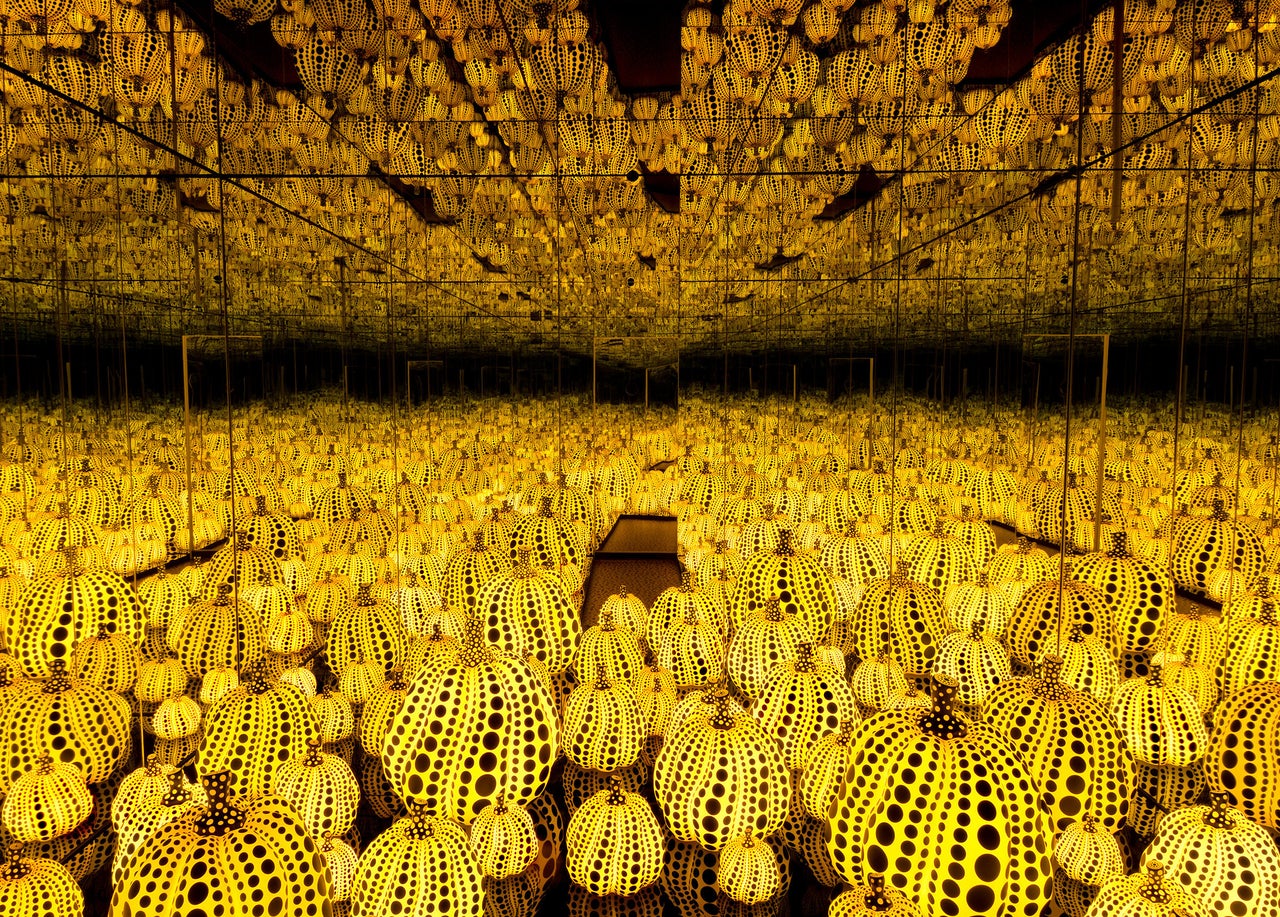
Today we have the World Wide Web, and the social networking that comes with it. Early in her career, Kusama had, or rather made, “infinity nets.” Her fixation with “infinity nets” originated when young Yayoi, a 6-year-old living in Matsumoto, Japan, began to hallucinate fields of polka dots that spread ravenously across every surface, object and person she perceived. To assuage the dread these phantom images incited, Kusama gave them concrete form. She began obsessively drawing and painting webs of polka dots and arcs that stretched as far and wide as the spots in her mind ― webs she called “infinity nets.”
“My nets grew beyond myself and beyond the canvases I was covering with them,” Kusama said in 1964. “They began to cover the walls and the ceiling and finally the whole universe.” She saw these works as images “without beginning, end, or center,” physical manifestations of her unceasing visions.
This endless, ephemeral expanse is today most closely mirrored by the internet, which reaches in every direction at once ― a horizontal playground of images, words, people and ideas. Zoom out, and all those profile pictures, tweets, memes and hot takes begin to resemble polka dots, hungry for camaraderie and visibility.
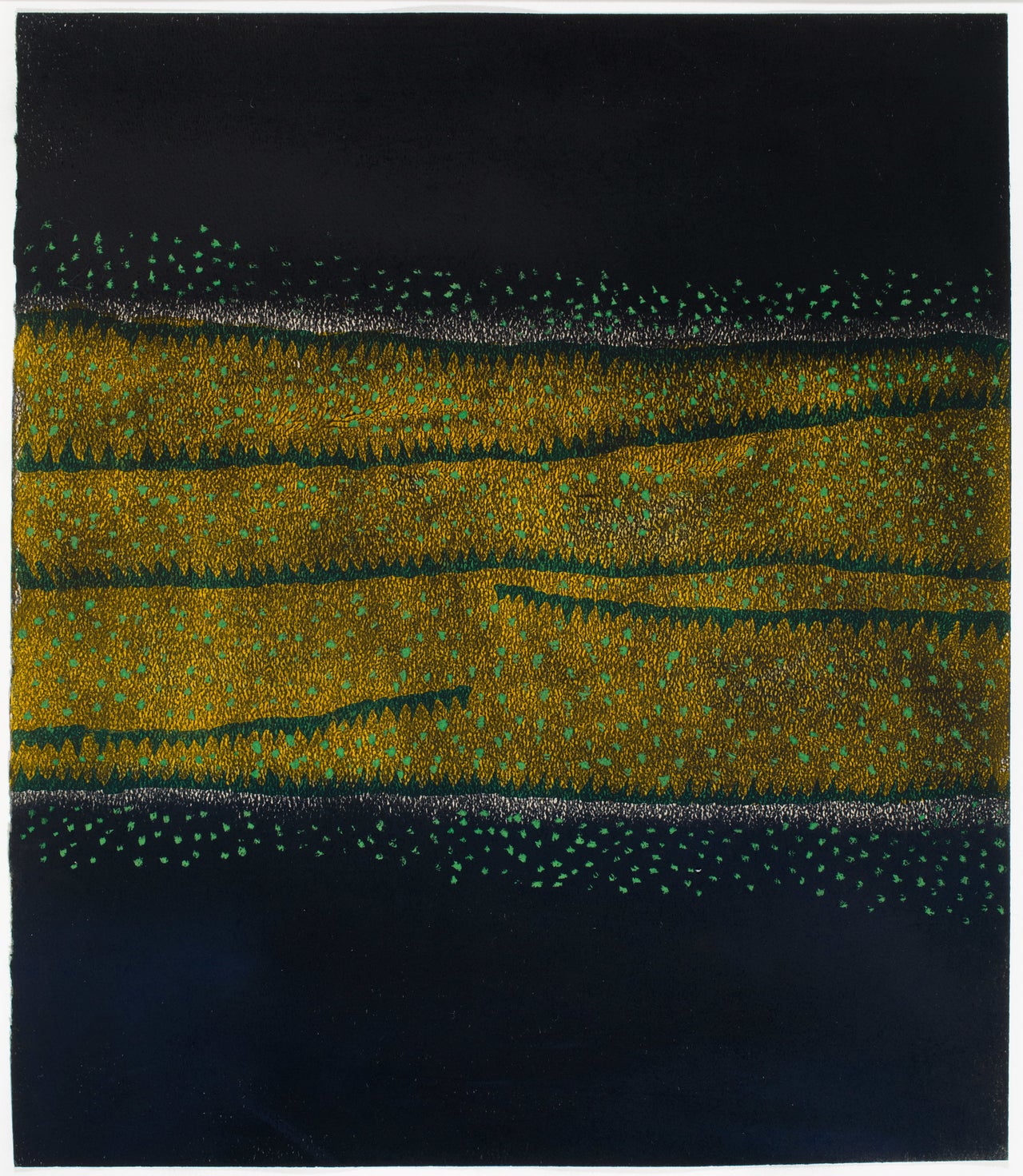
The “Infinity Mirrors” exhibition begins with a video greeting from Kusama herself, followed by a selection of her early works on paper, made in the 1950s, when Kusama first relocated from Japan to New York. The delicate works are abstract, flat expanses teeming with latticework; they recall bodily cells, honeycombs or clusters of bacteria seen from under a microscope. They are more corporeal, more organic, than the later work Kusama is most known for. They are also far less photogenic.
Here, Kusama is still operating in the material, natural realm, not having yet explored the option of transcending it.
It was 1965 when Yayoi Kusama first incorporated mirrors into her artistic practice. She had been in the process of creating “Accumulations” ― soft sculptures of phallic tubers that concretized her intense phobia of men and sex. Between 1962 and 1964, she made countless iterations of the drooping tentacles, but found the labor involved in making them physically and emotionally taxing. Kusama realized, then, that a mirror would allow her to exceed her own physical limits. Its reflective surfaces could balloon a finite number of sculptures into an unending field of them, echoing one another back and forth ad infinitum.
“Infinity Mirror Room ― Phalli’s Field,” Kusama’s first “Infinity Room,” is the first featured in the show. The ground is swarming with the red polka-dotted phalluses, each slightly distinct in length and girth. The walls are entirely mirrored, creating the disorienting illusion of a space that is limitless yet slightly claustrophobic. The viewer activates the space, and within it, she is multiplied and made strange. She comes face to face (to face) with infinite images of herself, captured from myriad angles and perspectives. She is everywhere and nowhere. She takes a selfie of her many selves.
Just walking into the space, one becomes an image. Taking a photo only amplifies the sensation.
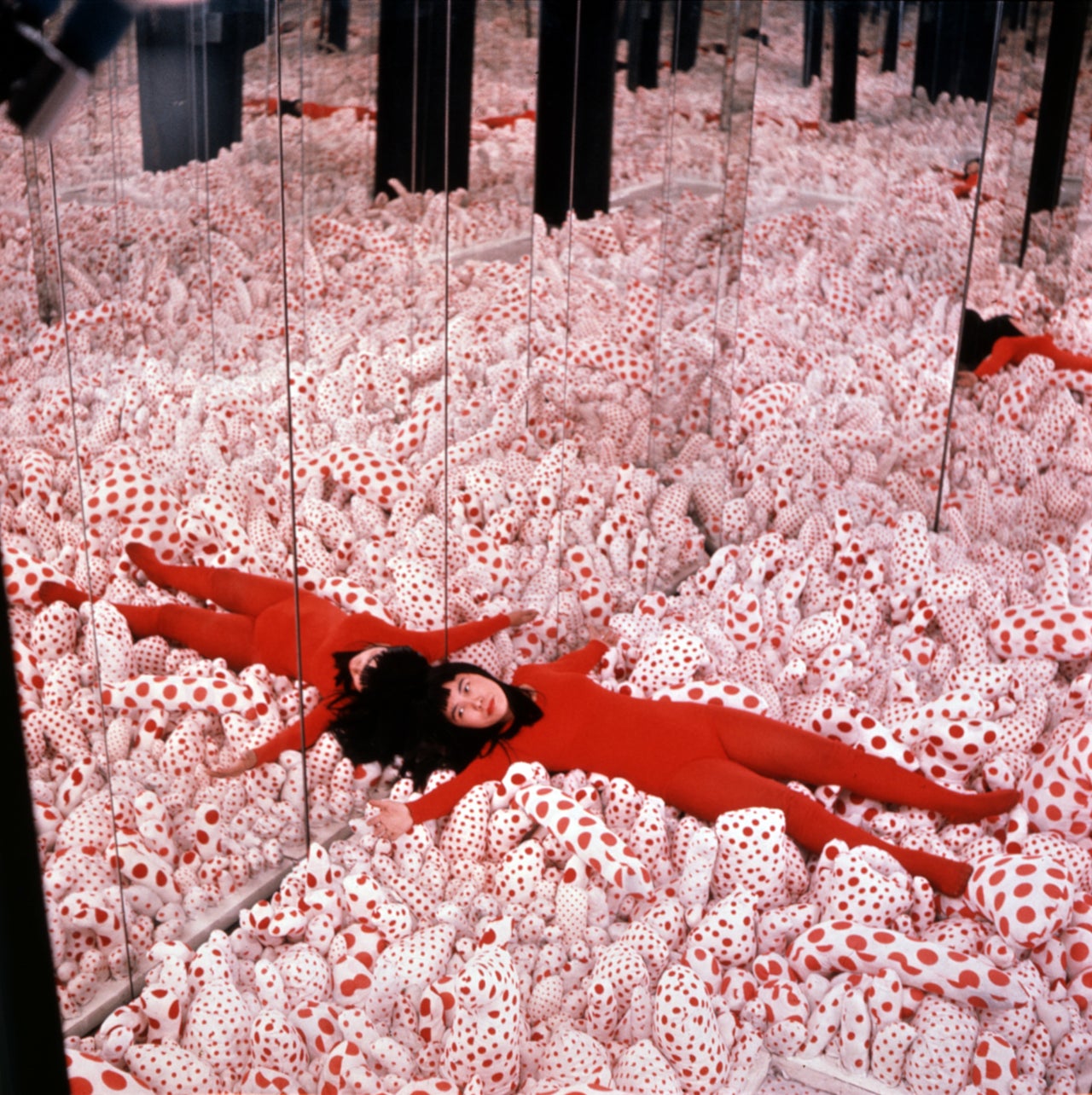
The impact of confronting innumerable repetitions of the self is not just aesthetic; Kusama argues it’s psychological. “When the people see their own reflection multiplied to infinity,” the artist said, “they then sense that there is no limit to man’s ability to project himself into endless space.” It’s a realization not far removed from the idea that one can transform an identity online by creating multiple usernames and accounts, or effectively warp an image using flattering angles and filters.
And just like that, the rigid boundaries that distinguish the discrete, certain self begin to wither. Kusama referred to this happening, of shedding your ego and melting into the “infinity net” of the universe, as “self-obliteration.” It is the experience her work aims to induce.
When Kusama first exhibited “Phalli’s Field” in 1965 at Castellane Gallery in New York, she posed for a series of photos in the space, a ritual she would continue to enact with most of her later “infinity rooms.” As art historian Briony Fer noted: “Kusama seems to have been keenly aware of the relationship between her installations and the photographs that were taken of them. A dispersal is enacted on the body to produce a proliferation of the body in pieces in the photographs as much as the installations themselves.”
The now iconic images of Kusama, shot by photographer Eikoh Hosoe, feature the artist dressed in a red jumpsuit, stretched languidly amongst the woolly barnacles ― part supermodel, part corpse. With her outfit, Kusama camouflages into her environment, eliminating the distinction between foreground and background, viewer and artwork. With her pose, the artist references the ways women’s bodies, in media and pop culture, have always been perceived first and foremost as images to be consumed. Even the artist, when a woman, becomes an object.
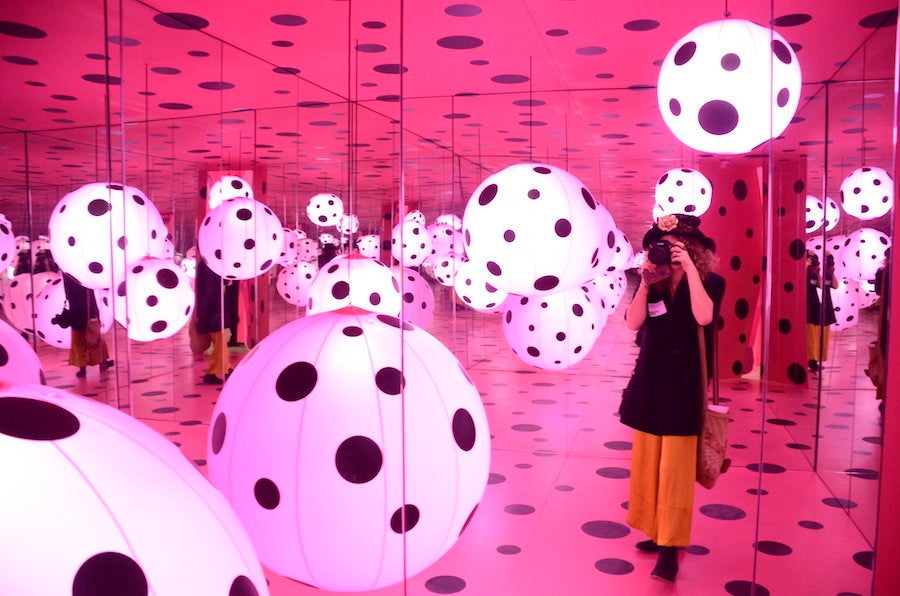
Through her photos, Kusama coopts the male gaze, becoming both creator and artwork, subject and object. It’s a ritual enacted by many young women today, who take selfies to allot agency to the female gaze, taking control of their own image-making and image-being at once.
The “Infinity Mirror” exhibition contains a variety of “Infinity Rooms,” each inviting the viewer to experience a different breed of discombobulating wonder. “Aftermath of Obliteration of Eternity” features strings of golden LED lights dangling throughout the space, twinkling on and off against the black glass floor. It’s like entering a pitch-black forest and being greeted by choreographed fireflies.
Another, “Dots Obsession — Love Transformed into Dots,” invites the viewer into a giant, pink polka dot filled with even more pink polka dots. For Kusama, these dots symbolize everything from the smallest specks to the biggest orbs. Throughout her career, she’s compared them to love, disease, the sun and the moon, the planet, the populous and the entire universe.
All of the “Infinity Rooms” are alike, however, in that they are meant to be experienced alone. Within their confines, viewers enter an uncanny pocket of isolation in the middle of a bustling museum, where they are forced to encounter a wholly singular kaleidoscope of themselves. Is this connectedness? Seclusion? Narcissism? Self-obliteration?
You face yourself as an element of your environment, not looking at the world but fully immersed in it, yourself a succession of selves. “Lose yourself in the timeless stream of eternity,” Kusama said. Upload your image to float amongst the countless other #InfiniteKusama content shared across virtual streams of all kinds.
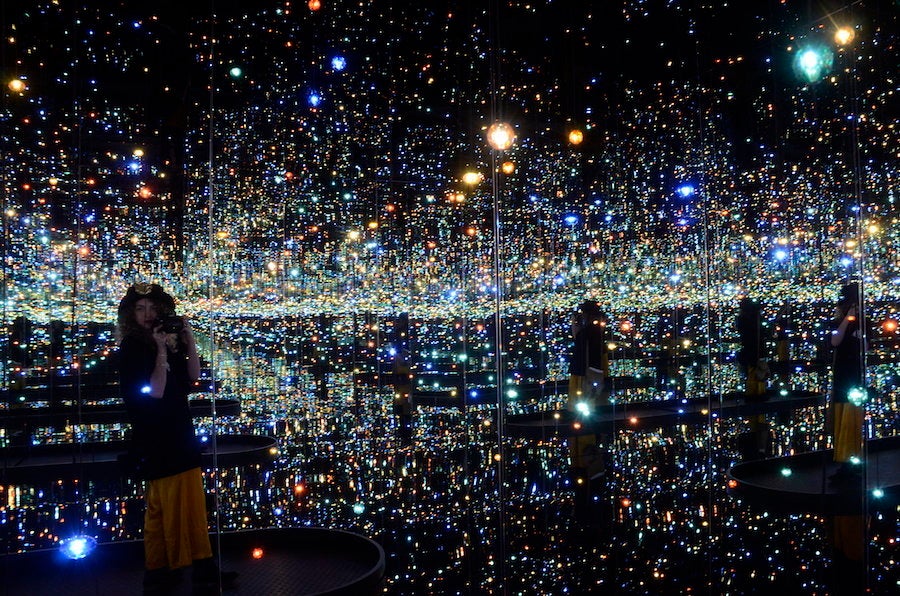
Amidst all the buzz of Kusama’s selfie-happy show, some will be tempted to dismiss the exhibition as frivolous art-as-entertainment, little more than a vacuous selfie op. And yet, Kusama’s lifetime of art stems directly from her lifelong battle with mental illness. “Painting saved my life,” she said in an interview with The Telegraph. “When I wanted to commit suicide, my doctor encouraged me to paint more. I fight pain, anxiety and fear every day, and art is the only method I have found to relieve my illness.”
Kusama has lived in a psychiatric facility in Tokyo since 1975, and continues to make art there for eight hours every day, as she approaches 88 years old. In this respect, Kusama’s art practice parallels portions of the internet that offer platforms of self-expression for many marginalized, oppressed or misunderstood communities. The show is only shallow in that it privileges the sacredness of surfaces; it’s only vain in that it forces you to confront yourself, over and over again. These factors intensify the works’ depth, relevance and significance. Like the online corners devoted to self-care and self-love, Kusama’s art possesses the power to save lives, including her own.
Although “Infinity Mirrors” is not didactically political, it makes a clear argument for the power of unlimited love. Love of oneself, love of others, love of earth and moon and universe and pumpkin. Following the model of the polka dot, Kusama shows how quickly boundaries between all things dissolve. Her work zooms out to show how people, like dots, resemble one another, and similarly, how much they need one another. “Polka dots can’t stay alone,” she told an interviewer in the 1960s.
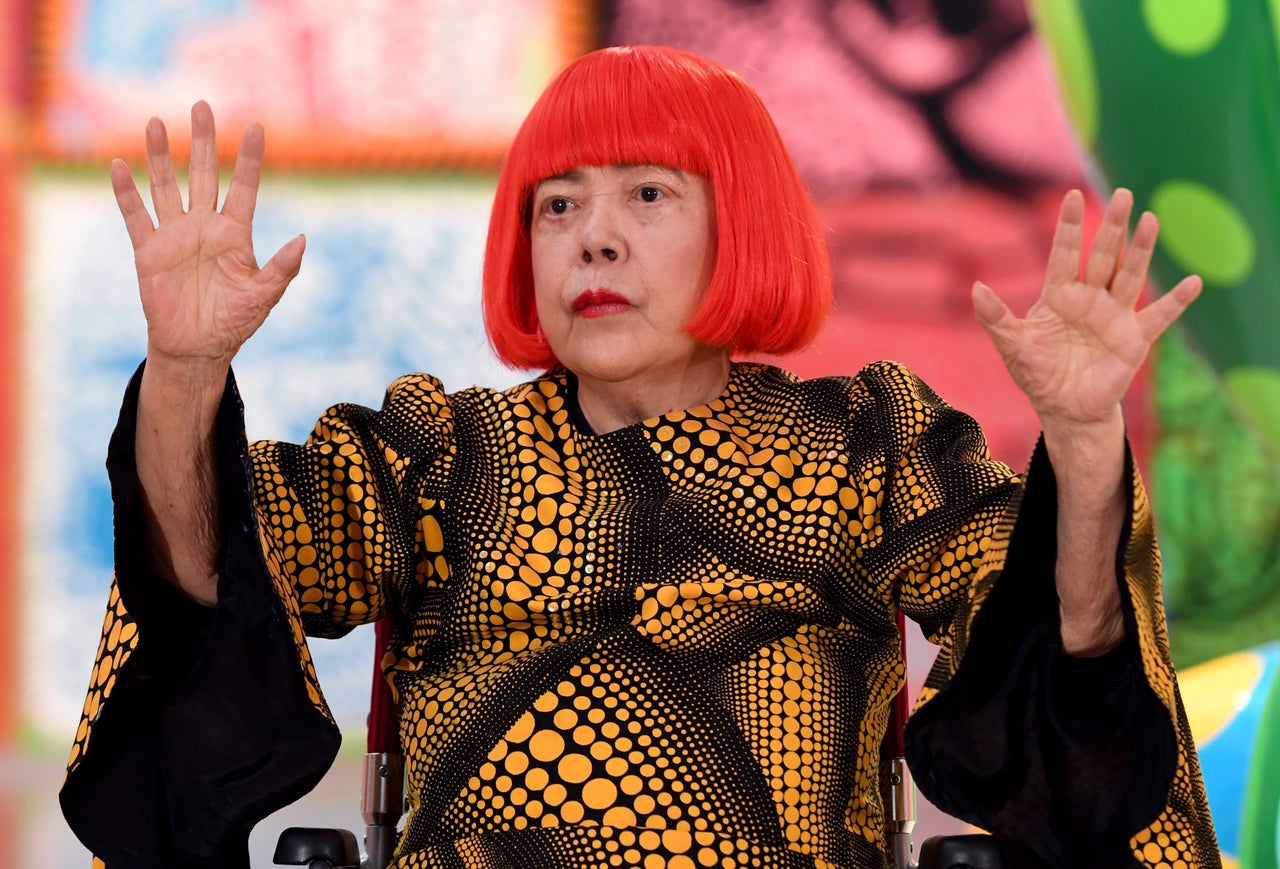
In the video introduction to the Hirshhorn show, Kusama, 87, speaks into the camera. She is wearing a red bob wig, matching lipstick, and a red polka-dotted dress, barely distinguishable from the work behind her. “The young generation is in control of an enormous future,” she says. Kusama reaches out to the next generation ― more resistant to labels and judgments than their predecessors, who live their lives both in person and on screen ― with tremendous hope.
Yayoi Kusama is one of the most influential artists of our time. Her work offered a stunning premonition of the world to come, her immersive installations speaking to the elemental, human urges that precipitated the internet’s omnipotence. Kusama understands our human desire to share, to transform, to be seen and to disappear. She understands our urge to exist in both the material and immaterial worlds at once, and that the latter offered opportunities for connectivity and self-effacement the real world never could.
“Polka dots symbolize disease,” she said in an interview with BOMB Magainze, hinting at the sick and strange desire to multiply oneself like a contagion ― to go viral.
“Infinity Mirrors” is a majestic exhibition from an artist whose grasp of the world is profoundly prophetic. The show looks so damn good on Instagram feeds and iPhone screens because, in effect, it belongs there, stretched across the infinite web of surfaces and reflections that Kusama first dreamed of over 70 years ago.
Feel free to hashtag #InfniteKusama.
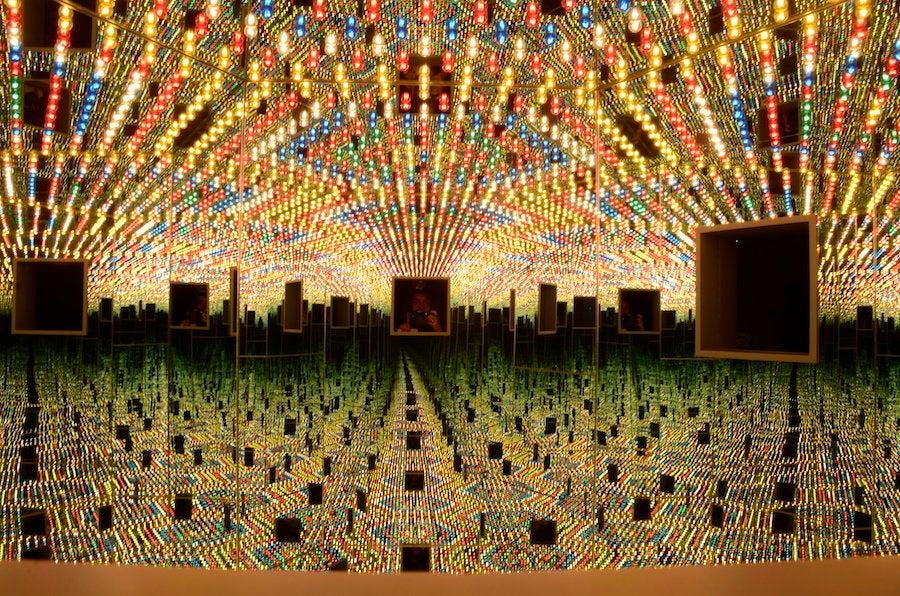
“Yayoi Kusama: Infinity Mirros” runs until May 14 at the Hirshhorn Museum in Washington, D.C. It heads to the Seattle Art Museum from June 30–Sept. 10; The Broad in Los Angeles from October 2017–January 2018; the Art Gallery of Ontario from March–May 2018; and the Cleveland Museum of Art from July–October 2018.
